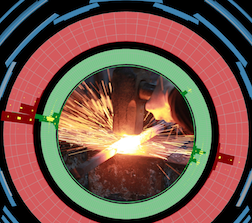Speaker
Description
The observation of a Higgs-like boson with a mass near 125 GeV/c2 at the Large Hadron Collider raises a critical question of whether the new particle is in fact the SM Higgs boson. Searches for non-SM Higgs boson production and its decay modes are therefore complementary.
I will report the searches for extended Higgs sectors performed with the CMS detector. I will focus on the NMSSM model, which is an extension of the minimal supersymmetric standard model (MSSM) by an additional gauge singlet field under new U(1)PQ symmetry in the Higgs sector of the superpotential.
Compared to the MSSM, the NMSSM naturally generates the mass parameter mu in the Higgs superpotential at the electroweak scale and significantly reduces the amount of fine tuning required. The Higgs sector of the NMSSM consists of 3 CP-even Higgs bosons h1,2,3 and 2 CP-odd Higgs bosons a1,2.
The latest CMS results, and prospects for Run 2 will be discussed.
Summary
The observation of a Higgs-like boson with a mass near 125 GeV/c2 at the Large Hadron Collider raises a critical question of whether the new particle is in fact the SM Higgs boson. Searches for non-SM Higgs boson production and its decay modes are therefore complementary.
I will report the searches for extended Higgs sectors performed with the CMS detector. I will focus on the NMSSM model, which is an extension of the minimal supersymmetric standard model (MSSM) by an additional gauge singlet field under new U(1)PQ symmetry in the Higgs sector of the superpotential.
Compared to the MSSM, the NMSSM naturally generates the mass parameter mu in the Higgs superpotential at the electroweak scale and significantly reduces the amount of fine tuning required. The Higgs sector of the NMSSM consists of 3 CP-even Higgs bosons h1,2,3 and 2 CP-odd Higgs bosons a1,2.
The latest CMS results, and prospects for Run 2 will be discussed.
